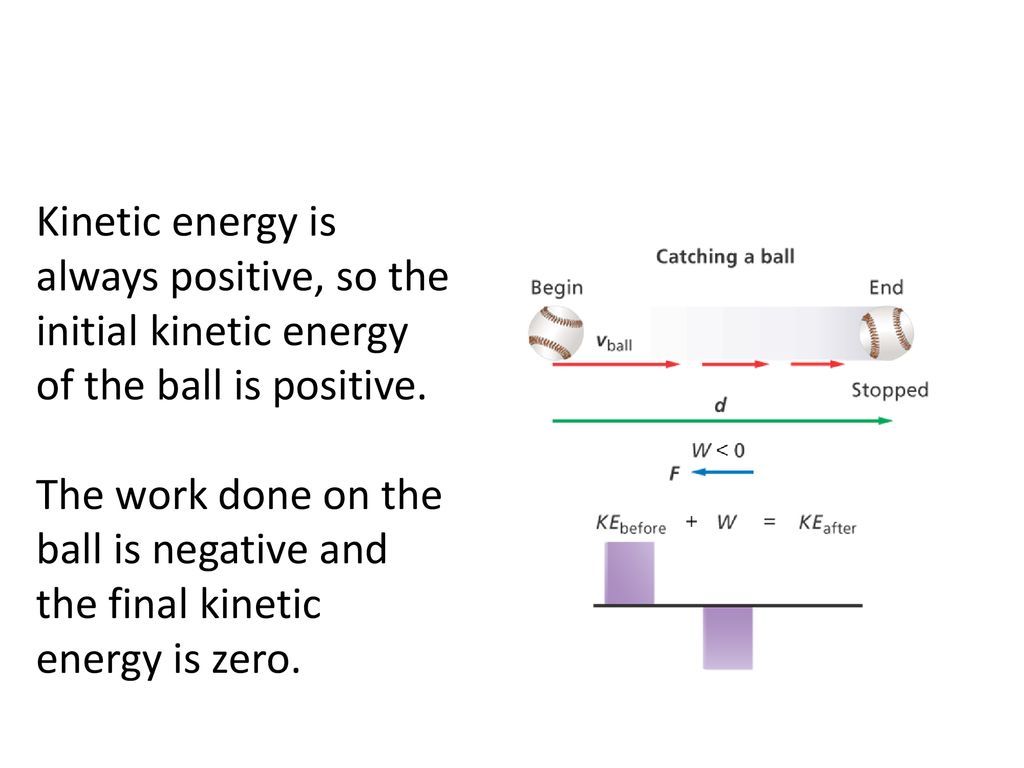Why Is Kinetic Energy Always Positive?
Definition of Kinetic Energy

Kinetic energy is the energy an object possesses due to its motion. It depends on both the mass and velocity of the object and is calculated using the following formula:
KE = 1/2 * m * v^2
Where:
- KE = Kinetic Energy (in Joules)
- m = Mass (in kilograms)
- v = Velocity (in meters per second)
This formula shows that as an object’s mass or velocity increases, its kinetic energy increases exponentially. Specifically, kinetic energy is directly proportional to the object’s mass and to the square of its velocity. For example, doubling the velocity results in a kinetic energy increase by a factor of 4.
Kinetic energy is therefore related to the motion of an object. The faster the object moves, the more kinetic energy it possesses. Additionally, heavier objects require more energy to accelerate to a given velocity than lighter objects. So at the same velocity, an object with greater mass has greater kinetic energy.
Kinetic Energy Formula
The formula for kinetic energy is:
KE = 1/2 * m * v2
Where:
- KE = Kinetic Energy (in Joules)
- m = Mass (in kilograms)
- v = Velocity (in meters/second)
This formula can be derived using calculus by relating the work done to accelerate an object to its resulting kinetic energy. The derivation starts with the definition of work:
W = F * d
Where:
- W = Work done (in Joules)
- F = Force (in Newtons)
- d = Displacement (in meters)
Using Newton’s Second Law that force is equal to mass times acceleration (F = ma), and relating acceleration to velocity using calculus, the work done can be related to the mass and change in velocity. This ends up giving the kinetic energy formula above.
The kinetic energy formula can also be derived using algebra and the definition of power. The derivation equates the instantaneous power delivered to an object to its change in kinetic energy over time. This ends up giving the same kinetic energy formula.
Units of Kinetic Energy
Kinetic energy is measured in joules (J) in the International System of Units (SI). The joule is defined as the kinetic energy acquired by a body with a mass of 1 kilogram that accelerates from rest to a velocity of 1 meter per second.
Specifically, the joule is equal to:
kg⋅m2/s2
Which is the kg (kilogram) x m (meters) squared per s (seconds) squared.
This unit comes directly from the formula for kinetic energy:
Ek = 1/2 mv2
Where m is mass in kg, v is velocity in m/s, and kinetic energy Ek is in joules (kg⋅m2/s2).
So the joule is the standard SI unit for measuring kinetic energy in physics and other scientific fields. Other obsolete or non-SI units like the foot-pound may be used in some contexts, but joules are most common in modern science.
Some key facts about joules:
- 1 joule = 1 kg⋅m2/s2
- 1 kilojoule (kJ) = 1000 joules
- 1 megajoule (MJ) = 1,000,000 joules
In summary, the joule derived from the kinetic energy equation is the standard unit for quantifying kinetic energy in the International System of Units.
Kinetic Energy Depends on Motion
For an object to have kinetic energy, it must be in motion. Kinetic energy is directly related to the motion of an object. The kinetic energy, Ek, of an object is defined by the following formula:
Ek = 1/2 mv2
Where m is the mass of the object and v is its velocity. This shows that if the velocity of the object is 0, meaning it is not moving, then the kinetic energy will also be 0. As The Physics Classroom states, “An object must have a measurable velocity in order for it to have kinetic energy.” This makes intuitive sense – if something is not moving, it has no “motion energy.”
Kinetic energy depends on the frame of reference. For a given object, if you view its motion from a reference frame where it has a velocity of 0, then it will have 0 kinetic energy in that frame. But it may have kinetic energy in other frames where it has a non-zero velocity. The key point is kinetic energy is directly related to an object’s motion.
Kinetic Energy Increases with Speed
Kinetic energy is directly proportional to the square of an object’s speed. This means that as an object’s speed increases, its kinetic energy increases exponentially. Doubling the speed of an object quadruples its kinetic energy. The faster the motion, the higher the kinetic energy.
The kinetic energy equation shows this relationship clearly: Kinetic Energy = 0.5 x Mass x Velocity2
The velocity term is squared, so increases in speed have an amplified effect on kinetic energy. For example, if velocity doubles from 5 m/s to 10 m/s, the kinetic energy increases by a factor of 4 (from 12.5 J to 50 J for a 1 kg object).
This is why moving objects like cars or bullets can generate such high kinetic energies. A small increase in speed leads to a large increase in energy. Kinetic energy’s dependence on the square of velocity is what makes high-speed collisions so destructive.
(Source: https://www.tutorchase.com/answers/a-level/physics/how-does-kinetic-energy-relate-to-speed)
Kinetic Energy is Frame Dependent
Kinetic energy depends on the reference frame from which it is measured. This is because kinetic energy is calculated using an object’s velocity, which itself depends on the frame of reference. Specifically, kinetic energy is calculated as (1/2)*m*v2, where m is mass and v is velocity.
For a given object with mass m moving at velocity v in one reference frame, an observer in a different reference frame moving at velocity u relative to the first will measure the object’s velocity as v+u. This change in measured velocity means the measured kinetic energy will differ between reference frames.
As an example, consider a car moving at 100 km/hr relative to the road. To someone standing still on the sidewalk, the car has a certain kinetic energy. But to someone driving next to the car in another vehicle moving at 100 km/hr, the car is stationary and so has zero kinetic energy.
Thus, kinetic energy is not an absolute quantity but depends on the observer’s reference frame. While total energy is always conserved, the division between potential and kinetic energy changes between reference frames. This frame dependence of kinetic energy is a key difference from potential energy.
For more details, see:
Kinetic energy with respect to different reference frames
Kinetic Energy is Always Non-Negative
Kinetic energy is always a positive quantity because it depends on the square of velocity. The formula for kinetic energy is:
KE = 1/2 * m * v2
Where m is the mass and v is the velocity. Velocity is squared in this formula. Since the square of any real number is always positive, the velocity component will always yield a positive value. For example, (-5 m/s)2 = 25 m2/s2.
The mass component is also always positive. Therefore, when you multiply a positive mass by a positive velocity squared, the result is always a positive kinetic energy.
Kinetic energy can be zero if the velocity is zero, but it can never be negative. An object at rest has no motion, so its kinetic energy is zero.
In contrast, potential energy can be negative, because potential energy equations do not square the velocity term. But kinetic energy’s dependence on the square of velocity ensures that it is constrained to be a non-negative quantity.
As a result, kinetic energy values provide useful insights about an object’s motion and speed. The sign of kinetic energy reveals whether an object is in motion (positive KE) or at rest (zero KE). This makes kinetic energy a helpful tool in physics calculations and analysis.
Potential Energy Can Be Negative
While kinetic energy is always non-negative, potential energy can be positive or negative depending on the reference point chosen. Potential energy represents stored energy due to position or configuration, such as gravitational potential energy near Earth’s surface or elastic potential energy in a compressed spring.
The zero point for gravitational potential energy is arbitrarily chosen, so values can be negative depending on the reference. For example, an object at infinity has zero gravitational potential energy, while an object close to Earth’s surface has negative gravitational potential energy due to the attraction of gravity. The more negative the potential energy, the more energy is stored.
In contrast, kinetic energy is always non-negative. It depends on an object’s motion and is the energy associated with movement. Kinetic energy increases with increasing speed, and is always positive regardless of direction or reference point. While potential energy relies on an arbitrary zero point, kinetic energy is an absolute measure of motion.
So while potential energy can be negative or positive based on the chosen reference, kinetic energy is always non-negative and absolute as a measure of an object’s motion. This key difference arises from the contrasting natures of stored potential versus motion-based kinetic energy.
Conservation of Energy
According to the law of conservation of energy, the total mechanical energy in a closed system remains constant. Mechanical energy refers to the sum of kinetic and potential energy in the system. This means that the total kinetic and potential energy is conserved, even as energy transforms between the two forms.
For example, as an object falls, its potential energy decreases while its kinetic energy increases. However, the total mechanical energy remains the same throughout the process. According to The Law of Conservation of Energy, energy cannot be created or destroyed, only converted between forms.
We can use the principle of conservation of mechanical energy to analyze mechanical systems. For a given system, we calculate the initial total kinetic and potential energy, and equate it to the final total kinetic and potential energy. This allows us to relate variables like height, mass, and velocity at different points in the system.
Examples and Applications
Kinetic energy is found everywhere in the world around us. Here are some common real-world examples:
Objects in motion like cars, trains, airplanes, and people walking all have kinetic energy due to their motion. The faster an object moves, the more kinetic energy it has. For example, a car traveling at 60 mph has four times as much kinetic energy as a car traveling at 30 mph.
Thermodynamics and heat engines like car engines, steam turbines, and jet engines all rely on converting thermal energy into kinetic energy. The hot gases produced from burning fuel expand and push on the engine’s pistons, turbine blades, etc., producing kinetic energy that is ultimately turned into useful work.
Roller coasters gain kinetic energy as they travel down hills and lose it as they climb hills. The kinetic energy accumulated at the top of a drop is converted into potential energy at the bottom of the drop.
Objects in space like planets, moons, asteroids, and comets have enormous amounts of kinetic energy as they orbit and traverse the solar system and galaxy. The Earth has around 2 x 1033 joules of kinetic energy due to its orbital motion.
Electricity generation often relies on kinetic energy, such as hydroelectric dams that use the kinetic energy of falling water to turn turbines, or wind turbines that use air currents to spin. Hydropower provides around 16% of the world’s electricity.
Our own bodies utilize kinetic energy every time we move – chemical energy from food is converted into kinetic energy to walk, run, dance, play sports, etc. The human body can generate around 67 watts of power when cycling at a moderate pace.
These are just a few everyday examples that demonstrate the ubiquity and usefulness of kinetic energy in our world.




